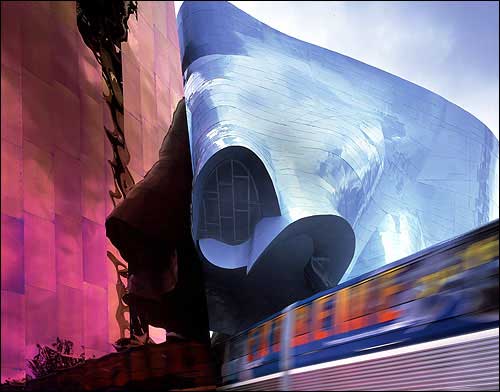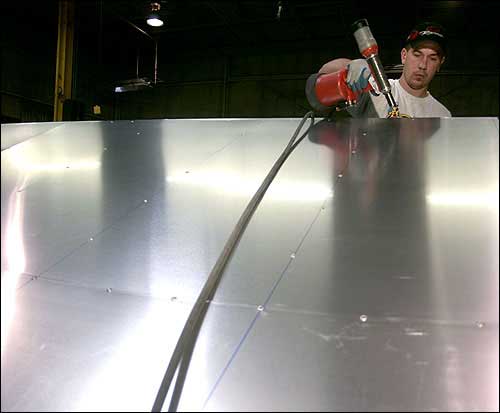Kansas City-based metals company builds international reputation
Kansas City, Mo. ? It’s unlikely that people driving by A. Zahner Co.’s headquarters would imagine the creative work going on inside the nondescript buildings.
A passer-by might notice different-sized, multicolored sheet metal with unusual designs stacked near the business, without realizing that many of those sheets were destined to become part of buildings, museums and artwork around the world.
In the past 15 years, Bill Zahner has turned the company — founded by his great-grandfather in 1897 — into a recognized leader in using metals in complex architectural or artistic projects.
A. Zahner’s reputation has grown partly because it is the company that architect Frank Gehry usually depends upon to determine how to color metal and make it bend to his adventurous and challenging designs. It was A. Zahner that installed the stainless steel “skins” covering Gehry’s Weisman Museum in Minneapolis and the Experience Music Project in Seattle.
Gehry began working with Bill Zahner in the late 1980s and continues to rely on his knowledge of metals and the techniques needed for unusual designs, said George Metzger, Gehry’s partner.
“We were impressed from the very beginning with how Bill understood the craftsmanship of working with metal itself, what types of metals we should use, and the architectural implications of metal,” Metzger said. “For years, he’s been a valuable resource for us.”
Business expands
Zahner, who has written two books on the use of metals in architecture, said he began studying metal because of the craftsmen at his Kansas City, Mo.-based company, which is privately owned.
“They can just touch a piece of metal and know what it is, how it’s going to work,” Zahner said. “I decided I really wanted to learn more about metal than we had known before.”

A. Zahner Co., a Kansas City, Mo.-based business, helped in the making of the Frank Gehry-designed Experience Music Project, a multicolored rock 'n' roll museum in Seattle. A. Zahner has become a recognized leader in using metals in complex architectural or artistic projects.
That altered the fortunes of A. Zahner, which previously had focused on more mundane metal work, such as siding, decking and heating ducts. Since he became company president in 1989 and chief executive officer in 1995, Zahner has added between 15 and 20 engineers, expanded the Kansas City plant to about 100,000 square feet and added another plant in Dallas.
About 200 people work for the company. They generally work on about 10 to 15 projects at once; current projects include the de Young Museum of Art in San Francisco and the Hunter Museum of American Art in Chattanooga, Tenn.
When Zahner took over, the company had a volume of about $5 million; current volume is more than $37 million.
Besides Gehry, the company has worked with other noted architects such as Rem Koolhaas, Antoine Predock, Daniel Libeskind and Tadao Ando, and companies such as The Walt Disney Co. The company also works with sculptors.
Building a reputation
Zahner said he had to overcome a perception that a company from Kansas City couldn’t handle high-end, difficult projects. And that perception still sometimes comes up, such as when Zahner was bidding to be part of the National Museum of the American Indian project in Washington.
Designers and architects wanted a building that reflected American Indian culture, including a copper wall that would look like it was dug from the earth 1,000 years ago. But they had no idea how to build it, make it structurally sound and get the right color tones.

Metal craftsman Brian Jackson fabricates a roof panel destined for the Hunter Museum of American Art in Chattanooga, Tenn. He worked on the project Oct. 4 at A. Zahner Co.'s headquarters in Kansas City, Mo.
“They thought there was no way a little company in Kansas City was going to be able to do this,” Zahner said. “They said ‘You can’t do it; we’ve talked to everyone in Europe.’ We walked in and blew them away.”
The three-year effort resulted in what Zahner calls the highlight of his career: a long, copper wall that looks like a woven basket, dropping from 10 feet to about 3 feet, that circles the museum’s entry rotunda.
“They put a lot of faith in what we did,” Zahner said. “They had no idea how to do it in metal. It was great to have the ability to produce what they wanted.”
Zahner’s engineers use computers to create three-dimensional models of proposed projects. The models ensure accuracy and precision in the design before the work is turned over to craftsmen.
Take the de Young museum, for which engineers figured out how to piece together 7,700 separate copper panels, all with different patterns of holes and bumps. The panels will be used to project an image of sunlight through the trees on the building’s outside walls.
“Part of our reputation is that we do very precise work,” Zahner said. “These designs are like pieces of a puzzle, and the computer helps us put them together.”
Zahner often speaks to architecture groups and students to encourage the use of computers in design work. That effort has helped the company’s reputation as one of the leaders in metal architecture work, said Ron Kemnitzer, a professor at the College of Architecture and Urban Studies at Virginia Tech.
Kemnitzer, who became aware of A. Zahner while teaching industrial design 15 years ago at Kansas University, said he had watched the company grow from a regional business to one with an international reputation.
“With the emphasis on computer engineering, the transformation is really pretty complete,” Kemnitzer said. “They have a high profile, partly because of their work with Gehry. But they are known for their custom, high-quality, complex metal work — emphasize high quality and complex.”

